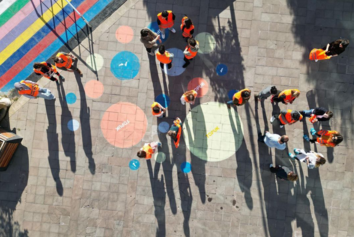2023 Award "Best Practice in Citizen Participation"
17th Edition
Maltepe, Istanbul: Women Accessing Public Transport Project (TOPUK)
Since urban planning requires too much expertise, benefiting from participatory methods in urban planning is relatively difficult, in this regard TOPUK is almost an unprecedented example of this experience. The methodologies applied throughout the project can shed light on further urban planning attempts.
This project focuses on improving gendered mobilities and promoting more inclusive streetscapes that cater to the needs of women as part of the greater society. While the primary objective of the case study is to improve access to public transport, the underlying understanding that our mobility experiences are holistic and should be handled as such has resulted in design ideas concerning recreation, socializing, general safety, and comfort in street experimentation.

In the TOPUK project, these objectives were undertaken through a clear project methodology and process employed by a balanced multi-stakeholder partnership. Participatory planning and design processes are essential in achieving these goals as well, as they ensure that women’s voices and experiences are incorporated into the street design process, leading to more inclusive and accessible public spaces for all.
The findings of this project reveal some points that may be helpful in steering future street experiments work in Maltepe and elsewhere. Among these are adopting a more egalitarian approach in selecting target groups for participatory events, employing team building activities among project partners and other relevant stakeholders in order to increase the efficiency of the decision-making process, and adopting a more systematic approach to the feasibility of design decisions in the short, medium, and long terms starting from the beginning of the planning phase. This way, the success of street experiments can be further ensured along with systemic change in urban mobility away from motorized traffic dominance and strategies that prioritize the needs of women in urban transport planning.
Even though the case intervention was not ‘women-only’, the participatory processes successfully incorporated women’s insights into the neighborhood into design and implementation.

One possible criticism might be the lack of a more women-inclusive participatory process design, in which one or more of the participatory events could have been tailored exclusively to women instead of the general public. However, having acknowledged that “interventions to improve access to city services and amenities for one will likely benefit the other”, participants from both the local community and the project actors strove for a street experiment inclusive of all.
In this sense, we are inspired by the call for the “feminist reimagining of public spaces as inclusive, caring, comfortable, sociable, and playful”. Regarding this point, it might also be worth mentioning that in most cases, as women constitute half of society, their mobility needs address those of society as a whole. Therefore, gender mainstreaming street experiments can be the way forward in creating more inclusive streetscapes.
More information:

This proposal has been accepted because:
Related proposals
Report inappropriate content
Is this content inappropriate?





0 comments
Loading comments ...
Add your comment
Sign in with your account or sign up to add your comment.
Loading comments ...